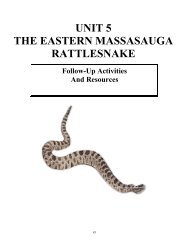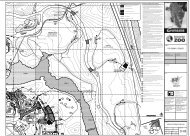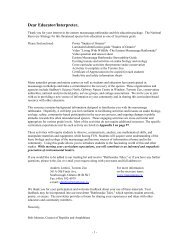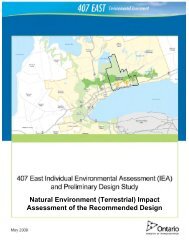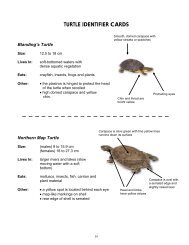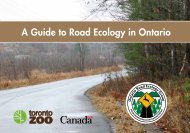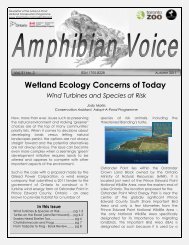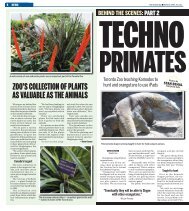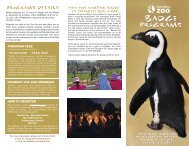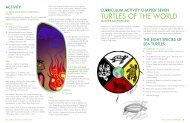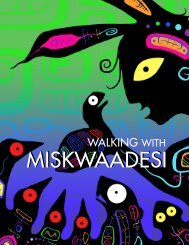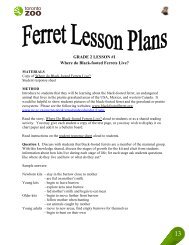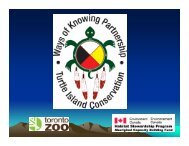Turtle Identification - Toronto Zoo
Turtle Identification - Toronto Zoo
Turtle Identification - Toronto Zoo
Create successful ePaper yourself
Turn your PDF publications into a flip-book with our unique Google optimized e-Paper software.
ACTIVITY #2:<br />
TURTLE IDENTIFICATION<br />
TOPIC<br />
What are some unique characteristics of the various Ontario turtle<br />
species?<br />
BACKGROUND INFORMATION<br />
For detailed information regarding Ontario turtles, see <strong>Turtle</strong>s of Ontario Fact<br />
Sheets (pages 10-26) or “<strong>Turtle</strong>s of Ontario” poster, or see web page<br />
www.torontozoo.com/adoptapond.<br />
MATERIALS<br />
Student work sheet (included)<br />
<strong>Turtle</strong>s of Ontario Fact Sheets (pages 10-26). Assign one turtle species to each expert group.<br />
METHOD<br />
Jigsaw: The class should be divided into small groups of five students, numbering each<br />
individual student from one to five. The teacher should make a copy of the fact sheets (pages<br />
10-26). The teacher should assign a specific turtle species to each “expert group” and distribute<br />
the corresponding fact sheet to each group. Using the chart provided, each student, within each<br />
working group, will fill out the information for their assigned turtle. Once this task is completed,<br />
students will move into their “home group” of students with the same assigned number. Each<br />
student will present their findings to the rest of their home group, ensuring that all group<br />
members complete the work sheet for all the turtles that have been assigned.<br />
The teacher should make copies of the <strong>Turtle</strong> Identifier Cards (pages 37-40) and black out the<br />
turtle names. The teacher should then distribute one set of cards to each home group of<br />
students. For all the turtles that have been assigned, students will then be asked to determine<br />
the names of the species pictured on each card. They can use their completed work sheets to<br />
identify the species on each card.<br />
32
ACTIVITY #2:<br />
TURTLE IDENTIFICATION: Student Work Sheet<br />
Distribution in<br />
Canada<br />
Blanding’s <strong>Turtle</strong> Northern Map <strong>Turtle</strong> Common Musk<br />
<strong>Turtle</strong><br />
Common Snapping<br />
<strong>Turtle</strong><br />
Habitat<br />
Description<br />
Feeding<br />
Status<br />
Conservation<br />
Concerns<br />
Interesting<br />
Facts<br />
33
ACTIVITY #2:<br />
TURTLE IDENTIFICATION: Student Work Sheet<br />
Distribution in<br />
Canada<br />
Eastern Spiny<br />
Softshell <strong>Turtle</strong><br />
Painted <strong>Turtle</strong> Spotted <strong>Turtle</strong> Wood <strong>Turtle</strong><br />
Habitat<br />
Description<br />
Feeding<br />
Status<br />
Conservation<br />
Concerns<br />
Interesting<br />
Facts<br />
34
ACTIVITY #2:<br />
TURTLE IDENTIFICATION: Answer Sheet<br />
Distribution in<br />
Canada<br />
Habitat<br />
Description<br />
Feeding<br />
Status<br />
Conservation<br />
Concerns<br />
Interesting<br />
Facts<br />
Blanding’s turtle Northern map turtle Common musk turtle<br />
aka: Stinkpot<br />
-southern Ontario -Great Lakes/St.<br />
-southern Ontario<br />
-western Quebec Lawrence watershed -Quebec, near the<br />
-Nova Scotia<br />
-southern Ontario Ottawa River<br />
-Quebec<br />
-highly productive<br />
water<br />
-soft-bottomed<br />
-dense aquatic<br />
vegetation<br />
-12.5-18 cm<br />
-carapace: smooth,<br />
domed, black to greybrown<br />
with yellow<br />
streaks/spots<br />
-plastron: black or<br />
yellow with dark<br />
blotches, hinged<br />
-chin & throat are<br />
yellow<br />
-bulging eyes<br />
-omnivorous<br />
-crayfish, insects,<br />
fish, frogs, plants<br />
-Ontario population<br />
not designated at risk<br />
in Ontario or by<br />
COSEWIC<br />
-Nova Scotia<br />
population designated<br />
as threatened by<br />
COSEWIC in 1993<br />
-abandons nesting &<br />
basking sites if<br />
disturbed<br />
-traffic mortalities<br />
-high nest predation<br />
-loss of wetland<br />
habitat<br />
-camouflaged<br />
carapace looks like<br />
duckweed<br />
-can live to 25 years,<br />
some say 70<br />
-hibernates<br />
underwater in mud<br />
-larger rivers & lakes<br />
-slow-moving, high<br />
quality water<br />
-soft-bottomed<br />
-males: 9-15.9 cm<br />
-females: 18-27.3 cm<br />
-carapace: oval with<br />
serrated back edge,<br />
slightly raised keel, olive<br />
green with yellow lines<br />
resembling map<br />
-plastron: yellow<br />
-head & limbs light yellow<br />
& dark stripes<br />
-yellow spot behind each<br />
eye<br />
-molluscs, insects, fish<br />
carrion, plant material<br />
-not designated at risk<br />
provincially in Ontario<br />
-designated as a species<br />
of special concern by<br />
COSEWIC in 2002<br />
-shoreline development<br />
destroys nesting habitats<br />
-vulnerable to water<br />
pollution (dependent on<br />
molluscs)<br />
-traffic mortalities<br />
-females begin eating<br />
after eggs are laid<br />
(usually July)<br />
-home range size greater<br />
for females than males<br />
-adults hibernate & bask<br />
communally<br />
-basking important for<br />
development of eggs in<br />
females<br />
-rivers, lakes & ponds<br />
-slow moving water<br />
-soft-bottomed<br />
-shallow areas<br />
-5.1-11.5 cm<br />
-carapace: domed,<br />
smooth, light olive to<br />
black in colour<br />
-plastron: small, yellowbrown,<br />
single hinge<br />
-single stripe above &<br />
below eye on both sides<br />
of head<br />
-chin & throat covered in<br />
barbels<br />
-omnivorous, often<br />
scavenging<br />
-bottom feeders<br />
-algae, carrion, small<br />
invertebrates, fish eggs,<br />
minnows, tadpoles<br />
-not designated at risk<br />
provincially in Ontario<br />
-designated as a<br />
threatened species by<br />
COSEWIC in 2002<br />
-occasionally caught by<br />
anglers using minnows or<br />
worms on hooks<br />
-habitat loss &<br />
fragmentation<br />
-nicknamed Stinkpot<br />
because of musky odour<br />
produced when handled<br />
-nocturnal<br />
-rarely leaves water<br />
-may climb trees or<br />
branches overhanging<br />
water<br />
-very aggressive<br />
-Ontario’s smallest turtle<br />
Common snapping<br />
turtle<br />
-occurs from Maritimes to<br />
southern Saskatchewan<br />
-parts of southern Alberta &<br />
New Brunswick<br />
-shallow ponds, rivers,<br />
streams, canals & lakes<br />
-slow-moving water<br />
-soft-bottomed<br />
-plenty of vegetation<br />
-20.3-36 cm<br />
-carapace: light brown to<br />
black, young turtles have<br />
raised keels<br />
-plastron: yellowish, very<br />
small & cross-shaped<br />
-two barbels on chin, neck is<br />
covered with rounded<br />
tubercles<br />
-serrated tail dinosaur-like,<br />
same length as carapace<br />
-omnivorous, often<br />
scavenging<br />
-fish, invertebrates, plants,<br />
toads, frogs salamanders,<br />
tadpoles, small turtles,<br />
snakes, young waterfowl,<br />
small mammals, carrion<br />
-not designated as a species<br />
at risk provincially in Ontario<br />
or by COSEWIC<br />
-traffic mortalities<br />
-sometimes considered<br />
human food delicacy<br />
-persecuted due to<br />
misinformation on its<br />
perceived threat to people, &<br />
game animals<br />
-rarely leave water<br />
-aggressive on land because<br />
of vulnerability due to small<br />
plastron<br />
-releases foul-smelling liquid<br />
from glands under carapace<br />
-world’s largest snapping<br />
turtle (32 kg) was once<br />
housed at <strong>Toronto</strong> <strong>Zoo</strong>.<br />
35
ACTIVITY #2:<br />
TURTLE IDENTIFICATION: Answer Sheet<br />
Distribution in<br />
Canada<br />
Habitat<br />
Description<br />
Feeding<br />
Status<br />
Conservation<br />
Concerns<br />
Interesting<br />
Facts<br />
E. spiny softshell Painted turtle Spotted turtle Wood turtle<br />
-southwestern Ontario -midland: southern -southern Ontario -Nova Scotia through<br />
-western Quebec Ontario; western: -southwestern Quebec southern Ontario<br />
north-western Ontario<br />
-lakes & rivers with soft,<br />
sandy bottoms<br />
-abundant aquatic<br />
vegetation<br />
-prefers waterways with<br />
sandbars or mudflats<br />
-male: 12.2-23.5 cm<br />
-female: 18.0-43.2 cm<br />
-carapace: leathery,<br />
flexible, olive-grey to<br />
brown with yellow<br />
border, edged in black,<br />
males have spots & tiny<br />
spines, females have<br />
camouflage pattern,<br />
small tubercles near<br />
neck<br />
-plastron: yellow-white<br />
-very long neck; ‘piglike’<br />
snout<br />
-feet are webbed, legs<br />
have yellow streaks<br />
-invertebrates, fish,<br />
crayfish, may eat<br />
aquatic vegetation<br />
-designated as a<br />
threatened species<br />
provincially in Ontario<br />
-designated as a<br />
threatened species by<br />
COSEWIC in 1991<br />
-traditionally collected<br />
for food<br />
-often caught on fishing<br />
lines<br />
-collisions with boats<br />
-poor water quality<br />
-buries itself in sand to<br />
hide from predators or<br />
ambush prey<br />
-bask communally<br />
-gets oxygen<br />
underwater through<br />
skin<br />
-ponds & marshes<br />
-soft-bottomed<br />
-slow-moving water<br />
-abundant basking sites<br />
-vegetation required<br />
-midland: 11.5-14 cm<br />
-western 9.0-19 cm<br />
-carapace: broad,<br />
smooth, flat, olive to<br />
brownish-grey; has<br />
orange-red margins<br />
-plastron: yellow with<br />
central blotch<br />
-neck, legs & tail are<br />
striped with yellow &<br />
red<br />
-yellow patch behind<br />
each eye<br />
-males have long nails<br />
on front feet<br />
-omnivorous<br />
-aquatic plants, frogs,<br />
small fish, aquatic<br />
invertebrates<br />
-not designated as a<br />
species at risk<br />
provincially in Ontario<br />
or by COSEWIC<br />
-traffic mortalities<br />
-loss of habitat<br />
-increase in natural<br />
predators, such as<br />
raccoons & coyotes<br />
due to human activities<br />
like garbage disposal,<br />
cornfields<br />
-no set territory or<br />
range<br />
-bask in large groups<br />
on logs, rocks or<br />
floating vegetation<br />
-bogs, marshes, & softbottomed<br />
lakes<br />
-quiet water<br />
-can be terrestrial in the<br />
spring<br />
-9-11.5 cm<br />
-carapace: black with<br />
small, bright yellow or<br />
orange spots, very<br />
smooth, no keels or<br />
serrations<br />
-plastron: yellow-orange<br />
with large black blotches<br />
or completely black<br />
-males: tan or black chin<br />
& brown eyes<br />
-females: yellow to<br />
orange chin & yellow to<br />
orange eyes<br />
-omnivorous<br />
-snails, aquatic insects &<br />
vegetation<br />
-designated as a<br />
vulnerable species<br />
provincially in Ontario<br />
-designated as a species<br />
of special concern by<br />
COSEWIC in 1991<br />
-kept commercially as<br />
pets<br />
-traffic mortalities<br />
-aquatic corridors drained<br />
-loss of wetlands<br />
preventing gene flow<br />
between populations<br />
-most active in early<br />
spring<br />
-aestivate in summer to<br />
avoid hot dry weather<br />
-near soft-bottomed,<br />
moving water such as<br />
streams, creeks, & rivers<br />
-riparian woods, shrub or<br />
berry thickets, swamps,<br />
open, grassy areas<br />
-14-20 cm<br />
-carapace: rough, heavily<br />
sculptured look, serrated<br />
marginal scutes & low<br />
central keels, brown to<br />
greyish-brown to yellow<br />
with black flecks<br />
-plastron: yellow with black<br />
blotch on each scute, v-<br />
shaped notch at tail<br />
-head & upper limbs are<br />
black<br />
-neck, lower limbs & other<br />
skin range from yellow to<br />
yellow-orange to orangered<br />
depending on locality<br />
-omnivorous<br />
-terrestrial plants,<br />
mushrooms, insects,<br />
worms<br />
-designated as a<br />
vulnerable species<br />
provincially in Ontario<br />
-designated as a species of<br />
special concern by<br />
COSEWIC in 1996<br />
-kept as pets<br />
-high nest predation<br />
-isolated populations<br />
-traffic mortalities<br />
-considered highly<br />
intelligent species of turtle<br />
-some individuals stomp<br />
the ground causing<br />
earthworms to surface<br />
36



